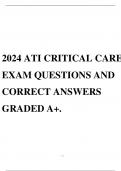Exam (elaborations)
2024 ATI CRITICAL CARE EXAM QUESTIONS AND CORRECT ANSWERS GRADED A+.
- Course
- Institution
2024 ATI CRITICAL CARE EXAM QUESTIONS AND CORRECT ANSWERS GRADED A+. 2 / 27 1. Before PFT's how long should a patient refrain from smoking? Using aninhaler?:smoking: 6-8 h inhaler: 4-6 h 2. What test must you do before performing an arterial puncture?: Allen's test;patency of the ulnar artery...
[Show more]



